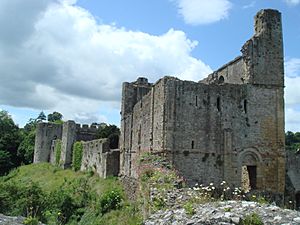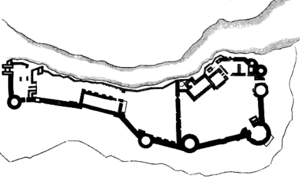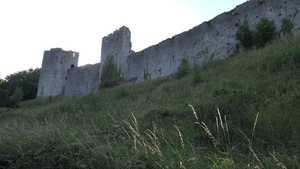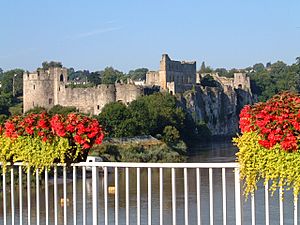Chepstow Castle facts for kids
Quick facts for kids Chepstow Castle |
|
|---|---|
| Chepstow, Monmouthshire, Wales | |
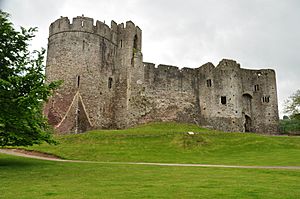
Chepstow Castle, with Marten's Tower to the left and the current gatehouse on the right
|
|
| Coordinates | 51°38′38″N 2°40′33″W / 51.6439°N 2.6757°W |
| Type | Castle |
| Site information | |
| Owner | Cadw |
| Open to the public |
Yes |
| Condition | Mostly Intact |
| Site history | |
| Built | 1067–1300 |
| Built by | William fitzOsbern William Marshal and his sons Roger Bigod |
| In use | 1067–1685 |
| Materials | Various forms of limestone and sandstone |
Chepstow Castle (Welsh: Castell Cas-gwent) is a very old stone castle in Chepstow, Monmouthshire, Wales. It's the oldest stone fortress in Britain that was built after the Roman Empire. The castle sits high up on cliffs next to the River Wye. Building started in 1067, ordered by a powerful Norman lord named William FitzOsbern.
This castle was first called Striguil. It was one of many castles built along the border between England and Wales, known as the Welsh Marches. Later, around the 14th century, it took the name of the nearby market town, Chepstow. In the 12th century, the castle helped the Normans conquer Gwent, which was an independent Welsh kingdom. Over time, two very strong Anglo-Norman lords, William Marshal and Richard de Clare, owned it. By the 1500s, the castle wasn't as important for fighting, so parts of it were changed into homes. It was used again during the English Civil War, but by the 1700s, it started to fall apart. Later, as more people started traveling for fun, Chepstow Castle became a popular place to visit.
Today, the castle ruins are protected as a Grade I listed building, which means they are very important historically.
Contents
Building Chepstow Castle: A Look at Its History
Chepstow Castle is built on a narrow piece of land between a tall river cliff and a valley called the Dell. You can see how big it really is from the other side of the River Wye. The castle has four main areas, called baileys, which were added at different times. Even with these additions, it wasn't the strongest castle for defense. It didn't have a very strong central tower (a keep) or a concentric design (walls within walls). Instead, its different baileys show how it grew over many years. Experts have studied the castle's building history, dividing it into four main stages.
Why Was Chepstow Castle Built? (1067–1188)
William the Conqueror quickly decided to build a castle at Chepstow because it was a very important location. Before the Normans arrived, there wasn't a big town here. The castle site might have been used as a fort even earlier, in prehistoric times or the early Middle Ages.
The castle overlooked a key crossing point on the River Wye. This river was like a highway, leading inland to places like Monmouth and Hereford. At that time, the Welsh kingdoms in the area were independent. The castle in Chepstow also helped stop Welsh attacks on Gloucestershire along the Severn shore. However, some recent studies suggest that the Welsh rulers of Gwent might have been friendly with the Normans at first.
The steep limestone cliffs next to the river made it a great place for defense. Building work started under William FitzOsbern in 1067 or soon after. The main tower, called the Great Tower, was probably finished by about 1090. It was likely built to show King William's power to the Welsh king Rhys ap Tewdwr. Unlike most castles built then, which were made of wood, Chepstow's Great Tower was built from stone right away. This showed how important it was as a stronghold on the border between England and Wales. Much of the stone came from nearby, but some blocks were even reused from old Roman ruins at Caerwent.
The castle was originally called Striguil, which comes from a Welsh word meaning "river bend." FitzOsbern also started a priory (a type of religious house) nearby. Over the next few centuries, the market town and port of Chepstow grew up around the castle. The castle and its surrounding land were known as Striguil until the late 1300s, and then as Chepstow.
How the Castle Grew: William Marshal and Roger Bigod (1189–1300)
More defenses were added by William Marshal, a powerful Earl, starting in the 1190s. The wood in the gatehouse doors has been dated using dendrochronology (tree-ring dating) to between 1159 and 1189. Marshal made the castle bigger and more modern. He used what he learned from fighting in France and during the Crusades (religious wars). He built the main gatehouse we see today and made the Middle Bailey stronger with round towers. Before he died in 1219, he might have also rebuilt the defenses of the Upper Bailey. More work on the Great Tower was done for William Marshal's sons until 1245.
In 1270, the castle was inherited by Roger Bigod, who was William Marshal's grandson. He built new buildings in the Lower Bailey for himself and his family to live in. Bigod also built Chepstow's town wall, called the "Port Wall," around 1274–78. King Edward I visited the castle in 1284, after his big tour through Wales. Soon after, Bigod built a new tower, now known as "Marten's Tower." This tower is a major feature when you approach the castle from the land side. He also updated the Great Tower.
Chepstow Castle's Later Years
Less Important for Defense (1300–1403)
From the 1300s, and especially after the wars between England and Wales ended in the early 1400s, Chepstow Castle became less important for defense. In 1312, it came under the control of Thomas de Brotherton. Later, his daughter Margaret took over. In 1403, during the rebellion led by Owain Glyndŵr, the castle had 20 soldiers and 60 archers. But because it was so big, not very important strategically, and had a good number of defenders, Glyndŵr's forces probably avoided attacking it. They did successfully attack Newport Castle, though.
From the 1400s to the 1600s
In 1468, the castle became part of the lands given to William Herbert, Earl of Pembroke. In 1508, it went to Sir Charles Somerset. He changed the buildings a lot to make them more comfortable for living. From the 1500s, after King Henry VIII removed the special powers of the Marcher lords, Chepstow Castle became more like a grand house than a fort.
The English Civil War and After
The castle was involved in the English Civil War. It was on the front line between the King's supporters (Royalists) and the Parliament's supporters (Parliamentarians). The Royalists held it, and it was attacked in both 1645 and 1648. It finally fell to the Parliamentarian forces on May 25, 1648. There's a memorial inside the castle to Sir Nicholas Kemeys. He led the Royalist defense and was killed in battle after refusing to give up.
After the war, the castle was kept as a fort for cannons and a place for soldiers. It was also used as a prison for important political figures. One famous prisoner was Henry Marten, who had signed the order to execute King Charles I. Marten was imprisoned here until he died in 1680.
Falling Apart and Becoming a Tourist Spot
In 1682, the Duke of Beaufort became the owner of the castle. The soldiers left in 1685, and parts of the buildings were taken apart. The castle was rented out and left to decay. Different parts of it were used as a farmyard and even a glass factory. By the late 1700s, its ruins, along with other places in the Wye Valley, became popular stops on the "Wye tour." These were fun boat trips down the river from Ross-on-Wye to Monmouth. The first guide book about the castle and town was written by Charles Heath and published in 1793.
The 1800s and 1900s
By the 1840s, more and more tourists were visiting, especially on day trips by steam ships from Bristol. The castle courtyard was used for local flower shows, festivals, and historical plays. In 1899, the Duke of Beaufort tried to sell the castle, but no one bought it.
In 1910-11, the castle was dug up by Dr. Orville Ward Owen. He was trying to find secret documents that he believed would prove that Francis Bacon wrote Shakespeare's plays. In 1913, the movie Ivanhoe was filmed there. The next year, a businessman named William Royse Lysaght bought the castle, and work began to preserve it.
In 1953, the Lysaght family gave the castle to the Ministry of Works to take care of. Later, in 1977, director Terry Gilliam filmed some scenes for his movie Jabberwocky at the castle. From 1984 to 1986, it was used as a filming location for the TV show "Robin Of Sherwood." In 1993, the heavy metal band Sepultura even recorded part of their album Chaos A.D. inside the castle. The castle was also used for filming scenes for the Doctor Who 50th anniversary special.
Chepstow Castle Today
Chepstow Castle is open to visitors. Since 1984, it has been looked after by Cadw. This is the Welsh government group that protects and promotes Wales's historic buildings. Special events are often held at the castle. Visitors can now walk along the castle walls and go inside Marten's Tower.
Images for kids
-
The castle and 1816 road bridge across the River Wye, seen from Tutshill
See also
 In Spanish: Castillo de Chepstow para niños
In Spanish: Castillo de Chepstow para niños




